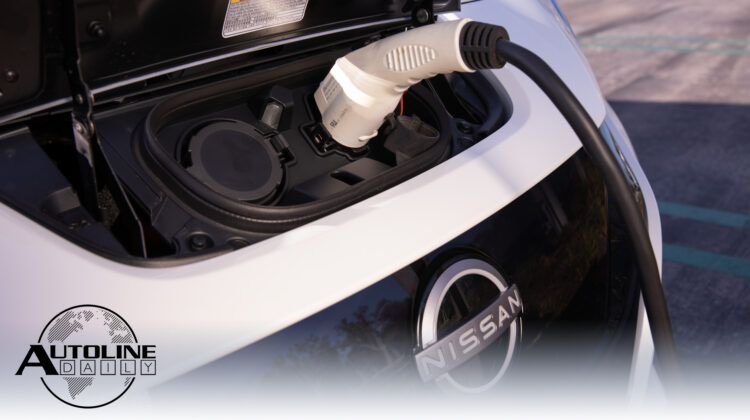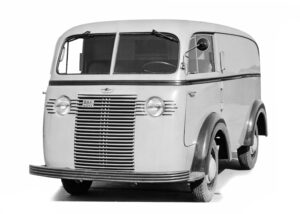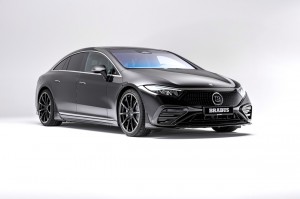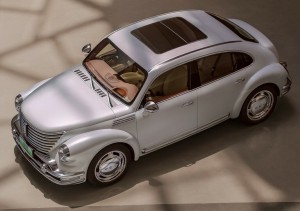
Listen to “AD #3392 – Used EV Prices Soaring; Got a Tesla Share? Now You Have 3; California Bans ICEs in 2035” on Spreaker.
Follow us on social media:
Runtime: 11:04
0:07 Got a Tesla Share? Now You Have 3
0:50 California Bans ICEs in 2035
1:55 And Hainan Bans ICEs in 2030
2:25 South Korea & EU Oppose U.S. EV Incentives
4:01 Hyundai Invests in Chip Maker
4:24 The Opel Van That Opel Never Knew Existed
5:14 Mercedes EQE Rolling Down the Line in China
5:38 Brabus Aero Kit Gives EQS More Range
7:01 Used EV Prices Soaring
7:54 Wey PHEV Goes Full Retro
8:51 Toyota’s Hitchless Towing
Visit our sponsors to thank them for their support of Autoline Daily: Bridgestone, Intrepid Control Systems, Schaeffler and Teijin Automotive.
This is Autoline Daily, the show dedicated to enthusiasts of the global automotive industry.
GOT A TESLA SHARE? NOW YOU HAVE 3
Yesterday Tesla’s stock closed at $891 a share. Today it opened at $301. And investors are loving it. That’s because they got two shares for every share they owned. It’s what they call a 3 for 1 split. If you had one share now you have three. Elon Musk has said in the past that Tesla stock was too expensive for many retail investors. But the split also gives him a lot more shares. If past history is any indication, Tesla stock will probably go back up near its pre-split levels. But not immediately. Analysts say investors tend to back off buying shares for weeks after a stock split.
CALIFORNIA BANS ICEs IN 2035…
California is getting serious about slamming on the brakes for internal combustion engines. The California Air Resources Board announced new rules banning sales of new ICE vehicles by 2035. And it actually starts sooner than that. In 2026, 35% of sales must be zero-emission. That ramps up to 68% by 2030 and 100% in 2035. BEVs, plug-in hybrids and fuel cell vehicles qualify as zero-emission, however hybrids can only account for 20% of an automaker’s lineup. EVs currently account for 15% of the Californian market. There are some exceptions, ICE vehicles won’t be banned from roads, you can still buy used ICE vehicles, and the state won’t prevent residents from buying a new ICE out of state and bringing it into California. The state estimates that the new regulations will cut CO2 emissions in half by 2040.
… AND HAINAN BANS ICEs IN 2030
And it’s not just California. The Chinese province of Hainan Island also announced an ICE ban starting in 2030. It’s the first province in China to ban ICE vehicle sales. It’s aiming for EVs to account for 45% of its overall vehicles by that time and it will offer tax breaks to get there. Cities in the province will also implement “zero-emission zones” where ICE vehicles will be banned from driving.
SOUTH KOREA & EU OPPOSE U.S. EV INCENTIVES
South Korea and Europe are really mad over the U.S.’s new Inflation Reduction Act, which excludes EVs built outside North America from receiving tax credits. South Korea wants to cooperate with the EU to fight the rules but it hasn’t revealed any concrete plans yet. The Korean Automobile Manufacturers Association said it will release a joint statement with the European Automobile Manufacturers Association next month. Korea said that the new U.S. law could impact as many as 100,000 EV exports annually. Here’s our Autoline Insight. South Korea and the EU have a legitimate beef and could likely win in court. But it will take years for that to happen.
HYUNDAI INVESTS IN CHIP MAKER
Hyundai isn’t messing around to make sure it never faces a chip shortage again. It’s investing in a chip startup called BOS Semiconductors, which is based in Korea. We don’t have a lot of details yet. BOS was only formed this year and Hyundai doesn’t say when it will start getting chips. But it says it will continue to make more investments like this.
THE OPEL VAN THAT OPEL NEVER KNEW EXISTED
Automakers keep extensive archives detailing their history, but photos recently came up for auction of an Opel van that the company had no idea ever existed. The prototype was designed in the mid-1930s and scribbled on the back in pencil was 1.5-23 COE. The 1.5 stood for the engine size, 23 was for the approximate wheelbase and COE stands for cab-over-engine. It looks to be a fully developed and running prototype with rearward hinging front doors. But Opel suspects it never went into production because of preparations for World War II. And had it gone into production, Opel would have been forced to stop building them after Germany lost the war.
MERCEDES EQE ROLLING DOWN THE LINE IN CHINA
Sales of the Mercedes EQE officially kicked off in China. It’s the first made-in-China model that rides on Mercedes’ electric architecture and will feature up to 10 exclusive upgrades, including Tencent’s video streaming service and optimized rear seats. Pricing ranges from about $77,000 up to over $85,000.
BRABUS AERO KIT GIVES EQS MORE RANGE
Speaking of Mercedes’ electric sedans, tuning company Brabus worked its magic on the EQS, but maybe not in the way you were expecting. Rather than go after power upgrades, it mainly went after aero. The exposed carbon fiber package reduces aerodynamic lift by 40% and lowers the vehicle’s overall coefficient of drag by over 7%. Between 60 and 85 MPH range is increased by about the same amount, 7%. The Brabus package also includes unique 22-inch wheels and an active suspension system that can lower the ride height for better handling. Pricing for the car starts at nearly $174,000, which is about $70,000 over the base car.
USED EV PRICES SOARING
This is a really good sign for EV adoption. Prices for used EVs are soaring in the U.S. iSeeCars reports that used EV prices were up a staggering 54% in July compared to a year ago, while used ICE vehicles were up just 10%. One reason used EVs demand is so high is because of soaring gas prices, better public charging, and a lack of inventory of new EVs. Somewhat surprisingly, the Nissan Leaf saw the biggest price increase, up 45%. A used Leaf now costs about $28,800 on average. But in terms of pure dollars, the Tesla Model S spiked the most, with its price jumping nearly $18,000 to $83,000 on average.
WEY PHEV GOES FULL PT RETRO
The newest PHEV from China sure looks like it took its inspiration from Chrysler’s PT Cruiser, with maybe a bit of the coffin-nosed Cord 810 and a 1953 Buick Roadmaster mixed into the front end grille. In fact, a lot of the design elements look like they were lifted right out of an old J.C. Whitney catalog. Even so, it sure is a head turner. This is the Wey Yuanmeng. Wey is one of the brands from Great Wall Motors. This PHEV is powered by a turbo 1.5 liter and an electric motor with a combined 238 horsepower. It reportedly can go an impressive 125 miles in pure electric mode. No word yet on what it’s going to cost but the car makes its official public debut tomorrow and when we get that info we’ll let you know.
TOYOTA’S HITCHLESS TOWING
Yesterday, Toyota demonstrated what it calls hitchless towing, where one car connects electronically with another car and follows it wherever it goes. For the demo, Toyota used two Sienna minivans going through turns and simulating lane changes. It can even do a slalom course. Toyota says this would be perfect for a small group of cars going to a cottage or a football game. The following driver can take control at any time, and the system will only allow turns and lane changes that are safe for the following cars. But once the cars are connected, it doesn’t even need a driver in the following car. Impressively, hitchless towing only requires minimal hardware and software, and a wireless connection between the cars. Conceptually, hitchless towing is a lot like truck platooning. But platooning is for limited access highways, while hitchless towing is meant to be used anywhere. This is still a technology that’s under development, but we wanted you to be some of the first people to see it.
AFTER HOURS & COMMERCIAL EVS
We’ve got a different Autoline After Hours coming up this afternoon. We actually recorded it Saturday morning at the Dream Cruise in Detroit. But it’s not about the Dream Cruise, it’s about how electric trucks, vans and buses are catching on faster than electric cars. We’ve got a couple of execs from Navistar and a sustainability expert weighing in on why the commercial truck market is so receptive to electric vehicles. And you can catch that show at its regularly scheduled time at 3 pm eastern time on our Autoline website and YouTube channel.
But that’s a wrap for today.
Thanks to our partner for embedding Autoline Daily on its website: WardsAuto.com
Seamus and Sean McElroy cover the latest news in the automotive industry for Autoline Daily.









